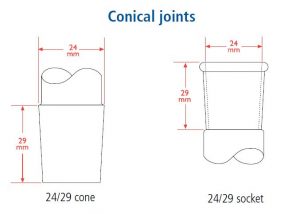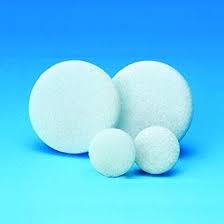Vitraform - Technical Information
Whether you purchase Schott, Pyrex or Glassco products, the glassware used in the manufacturing of most of their items is made from Boro 3.3. glass. Right from 16th Century, chemical research teams have used glass containers for a very basic reason; the glass container is transparent, almost invisible. And so the contents and the reaction are clearly visible. But because chemists must heat, cool and mix chemical substances, ordinary glass is not always adequate for laboratory work.
Laboratory work requires apparatus made in a glass – which can readily be molded into any desired shape or form, which offers maximum inertness when in contact with the widest range of chemical substances, which can withstand thermal shock without fracture and high temperature (450 Deg C), work without deforming, and which will be resilient enough to survive the everyday knocks to which it will be subjected in normal laboratory handling, washing and sterilizing processes.
Borosilicate 3.3 glass represents unmatched standardized glass for construction of plant and piping in the chemical, dyestuff, food pharmaceutical, petrochemical industries. Borosilicate glass is also very widely used for scientific applications. Made from low thermal expansion borosilicate glass its intrinsic qualities of resistance to physical and chemical attack and ability to stand thermal shock make it an ideal material of construction for scientific and laboratory apparatus’.
Its steadily growing use is due to many advantages over conventional materials.
- Outstanding corrosion resistance
- Smooth pore free surface
- Transparency
- Catalytic inertness
- No effect on taste and odor
- Physiological inertness
Borosilicate 3.3 glass tubes represent optimum mechanical, thermal and chemical behavior. This glass is used in laboratories as well as for industrial applications where maximum thermal resistance, thermal shock resistance, mechanical resistance as well as unusual chemical resistance are required.
Borosilicate 3.3 glass tubing is drawn on fully automatic machines which permit close tolerances on dimensions. These also undergo careful and strict quality control. A large and comprehensive range of standard tubing in diameters from 4 mm to 180 mm and in light, medium and heavy wall is available.

Ground glass joints are used in laboratories to quickly and easily fit leak-tight apparatus together from commonly available parts. Some laboratory bottles like Reagent Bottles can also come with standardized conical joints & stoppers in plastic or glass.
Ground glass joints can be precisely ground to a reproducible taper or shape. They are made to join two glassware pieces together. One of the glassware items to be joined would have an inner (or male) joint with the ground glass surface facing outward and the other would have an outer (or female) joint of a correspondingly fitting taper with the ground glass surface facing inward.
The conically tapered ground glass joints typically have a 1:10 taper and are often labeled with a symbol consisting of a capital B. This symbol represents a medium length joint and is followed by a number, a slash, and another number e.g. 24/29. The first number represents the outer diameter (OD) in millimeters (mm) at the top (widest part) of the inner joint. The second number represents the ground glass length of the joint in millimeters.

When to Choose a Sintered Disc
The main reason a sintered disc would be chosen is when you are working with corrosive chemicals that would damage filter paper. The sintered discs are made entirely of borosilicate 3.3 glass, meaning they are resistant to a wide range of corrosive chemicals. As the discs are not affected by ammonia, sulphuric acid and other solvents which can be damaging to filter paper, a sintered disc is a good choice if you are using these products.
How to Care For Sintered Disc Glassware
When using a new sintered disc you should rinse it with mild Hydrochloric Acid solution, then rinse again several times with distilled water, to remove any residual glass dust particles left over from manufacture. After each use rinse thoroughly with water to keep the disc clean from particulates. As with all boroscilicate 3.3 glass, the discs can withstand heating and cooling but take care that this is done slowly and uniformly to avoid thermal shock.
Pressure And Vacuum
Small scratches or internal abrasions of the glass surface can greatly reduce the vacuum or pressure resistance. Filter pores may clog during filtration and cause a pressure drop. In any case, 1 kp/cm2 may not be exceeded. Never subject glassware to sudden pressure changes.
Temperature Resistance
The maximum allowable service temperature is approx. 450 Deg C. To avoid permanent stress, the heating and cooling rate should not exceed 5 Deg C/min. Wet glass-filters should be heated slowly up to 80 degrees C and dried for one hour, before temperature is increased. Permanent stress can reduce the mechanical and thermal resistance. Never subject glassware to sudden temperature changes.
What do The Porosity Grades of Sintered Discs Mean?
- Sintered discs are supplied in various porosity grades – these related to the range of pore sizes present within the disc.
- At a practical level this means particles stopped by the disc will generally be at the upper end of the range.
- The table below shows the porosity grades and actual pore sizes;
- Porosity Grade ISO 4793 Designation Pore Index (microns µm), Principal Uses.
- 0 P250 (160 – 250um) Coarse filtration, gas dispersion, support for other filter material (e.g. column chromatography)
- 1 P160 (100 – 160um) Coarse precipitate filtration, gas dispersion, coarse grain material filtration
- 2 P100 ( 40 – 100um) Medium and crystalline precipitate filtration, medium filtration and washing of gases
- 3 P40 ( 16 – 40um) Analytical work with medium precipitates
- 4 P16 ( 10 – 16um) Analytical work with fine precipitates
- 5 P10 ( 4 – 10um) Bacteria filtration